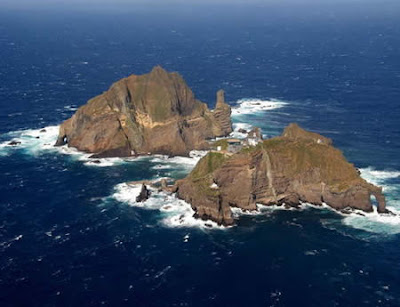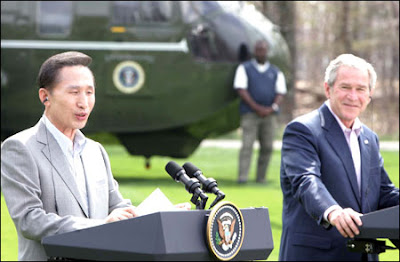
|
|
Time Magazine reported in 2006 that the the Upsala Glacier (above), part of the South American Andes in Argentina, has dramatically retreated. The upper picture is how it looked in 1928, and the lower picture is how it looked in 2004. It reportedly has been retreating at least 180 feet (54 meters) per year.
|
Did scientists in the 1970s really predict an ice age, and if so, what's up with that?
Well, yes, they did. That meme is a favorite counterpoint by those who think that global warming is all a fantasy by Former Vice President Al "Chicken Little" Gore. The thinking apparently goes, "How can we trust scientists who tell us today that the Earth is warming up when those same scientists warned us in the 1970s that we were headed for an ice age?"
Good question. For answers, let's go back to what the scientists were saying four decades ago.
Indeed, in the 1970s scientists were reporting that the Earth had cooled by 0.2 degrees Celsius since 1945. The result was, scientists explained at the time, due to particulate matter, which is sometimes a human creation (but certainly not always, witness volcanic eruptions and naturally occurring forest fires and brushfires). This in turn led to greater cloud cover and more cooling. Nuclear winter lite, one could call it.
But since the 1970s, the United States and the rest of the industrialized world have been working to reduce pollution from particulate matter. I know that California, where I grew up, has much cleaner air than back when I was growing up in the 1970s and 1980s. Without the
yŏntan coal bricks burning in every home and far fewer dirty Diesel vehicles, South Korea's air quality has also improved considerably. In other words, reduction of manmade particulate pollution may have reversed that trend.
The other point to be made is that in the 1970s, people were in fact predicting global warming for the very same reasons as now, and those factors have not changed much.
So that's the skinny behind the oft-cited "prediction" of 1970s scientists that we'd be in an ice age by now.
Here's a snippet from
Time Magazine, dated February 2, 1970 (cover shown above):
Some environment experts visualize future dramas of disaster that seem to border on science fiction. A few scientists feel that the outpouring of carbon dioxide, mainly from industry, is forming an invisible global filter in the atmosphere. This filter may act like a greenhouse: transparent to sunlight but opaque to heat radiation bouncing off the earth. In theory, the planet will warm up. The icecaps will melt; the oceans will rise by 60 ft., drowning the world's coastal cities.
Other scientists argue the exact opposite: they point out that the earth's average temperature has dropped by .2° C. since 1945, though the carbon dioxide content of the air keeps increasing every year. To explain this phenomenon, many ecologists think that various particles in the atmosphere are reflecting sunlight away from the earth, thus cooling the planet. Since about 31% of the world's surface is covered by low clouds, increasing this cover to 36% through pollution would drop the temperature about 4° C.—enough to start a return to the ice age.
Make of that what you will.
The following Time article from August 9, 1976 (cover below), addresses the same issues—particles causing cooling perhaps offset by a greenhouse effect. Here they report that since 1949 temperatures in the Northern Hemisphere were one degree Celsius cooler, which would be disastrous if they occurred globally:
Climatologists admit that they really do not know. A substantial number believe the earth is undergoing a cooling trend and is returning to the conditions of the "Little Ice Age"—the generally cold, damp weather that prevailed from around 1600 to 1850. British Climatologist Hubert Lamb believes the change is cyclical, occurring every 200 years or so. Reid Bryson of the University of Wisconsin and many others blame the earth's cooling on an increase of dust particles in the atmosphere; the particles act like tiny mirrors, reflecting back some of the sunlight sinking the atmosphere and depriving the earth's surface of solar heat.
There is some evidence that the earth had cooled down—at least temporarily—in the 1950s and 1960s. In 1972, according to German Climatologist Horst Dronia, the atmosphere in the Northern Hemisphere was one full degree centigrade colder than in 1949. But there have been indications of a slight warming since then. If the cooling-theory school is correct, however, the prospects for man are chilling. A global average temperature drop of only 1° could shorten the growing seasons in the temperate zones by a critical week or more and reduce food supplies. Increased heating requirements would put a further strain on energy sources.
Other climatologists believe that any long-term cooling trend is being offset by a "greenhouse effect," caused by an increasing atmospheric content of carbon dioxide produced by the burning of fossil fuels. The CO2 prevents some of the heat radiated by the earth's surface from escaping out into space, thus warming the planet's atmosphere. Warming-trend advocates note that winters in such normally chilly regions as Scandinavia and New England have been uncharacteristically mild in recent years, and glaciers in the Alps have actually retreated. Even a modest rise in world temperatures would bring with it other perils. Ocean levels raised by melting polar ice could drastically change global air-circulation and rainfall patterns, as well as cause extensive flooding. The result could be a radical decline in the productivity of many of the world's important agricultural regions.
Climatologists tend to agree that whatever the long-term trend, the earth's climate is entering a period of increased variability that will make prediction and planning ever more difficult. "I do not see glacial melts or an ice age," says Jerome Namias of the Scripps Institution of Oceanography in La Jolla, Calif. "What I see is fluctuations." Stephen Schneider, deputy head of the climate project at the National Center for Atmospheric Research in Boulder, Colo., says the evidence of the past few years suggests that there is a good possibility the climate is becoming more unpredictable.
To learn more about these fluctuations, an international consortium of scientists is compiling a record of the earth's climate. Climatologist Lamb and his colleagues have assembled an accurate historical record of the seasons going back as far as 1400 A.D.—based on parish registers, government documents, monastery records, and such physical evidence as sediment deposits in lakes and growth rings in trees. Says Lamb: "The more we know about cycles of the past, the better we can work with the highly detailed and sophisticated observations we have of our weather today." Geophysicist Willi Dansgaard of the University of Copenhagen is studying cores taken from the ice in Greenland and Antarctica to learn about temperature and precipitation through the ages. Researchers at Columbia University's Lament-Doherty Geological Observatory are examining sea-floor cores for clues to ocean temperatures and circulation.
Put that in your pipe and smoke it, naysayers who like to tell us what scientists in the 1970s said. I think it's interesting to note that now that we have a better record—as they were starting to put together in the 1970s—the consensus on global warming due to manmade causes has become stronger and stronger (though not universal).
Personally, I don't think this is something that can ever convince everybody. I think it's entirely possible we may wake up tomorrow and realize that it was all a great miscalculation. But erring on the side of caution would be to try to clean up the environmental mismanagement we have inflicted on our waters and our atmosphere, and the efforts to curb global warming is a major part of that drive. In other words, even if it turns out we have exaggerated the effect of manmade carbon dioxide and other greenhouse gases, we still would win if we made strenuous efforts to reduce them.
...
Sphere: Related Content
 With mounds shaped like these, the Japanese won't be able to resist grabbing your Toktos.
With mounds shaped like these, the Japanese won't be able to resist grabbing your Toktos.

























